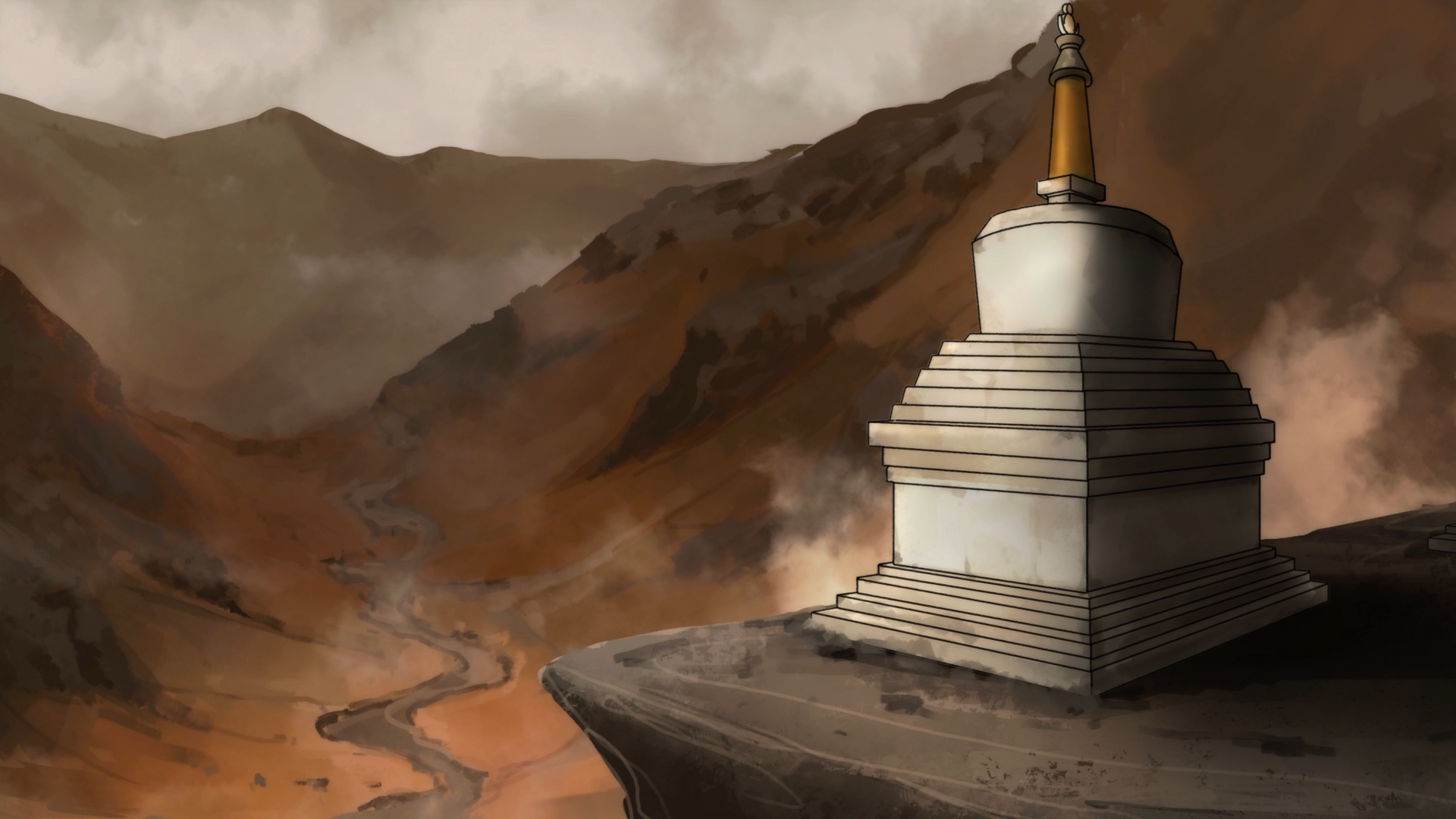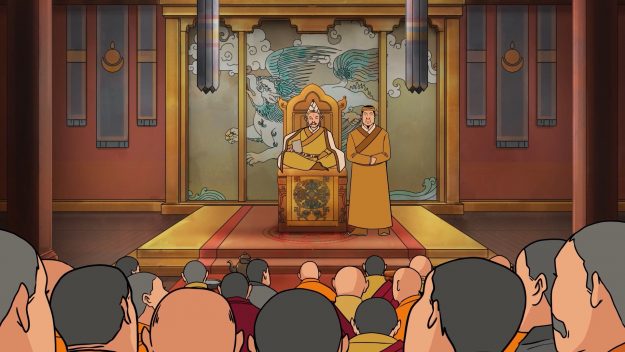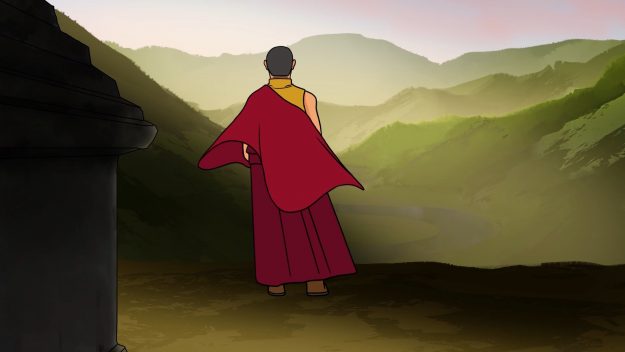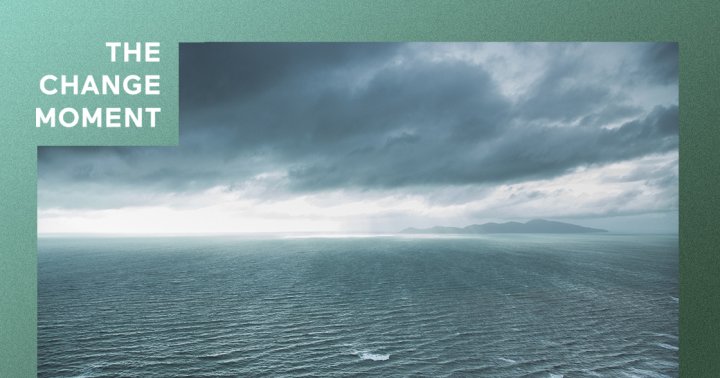Building a Historical Narrative of Tibet
Two of the minds behind The Animated History of Tibet talk with Tricycle about the show’s creation, pivotal figures, and what it means to tell the story from a distinctively Tibetan perspective. The post Building a Historical Narrative of...

For more than two hundred years, the Tibetan Empire was one of the greatest military, political, and cultural forces in all of Central Asia, maybe even the entire world, ruling over a vast territory that included parts of modern-day Afghanistan, Bangladesh, Bhutan, Burma, China, India, Nepal, Pakistan, Kazakhstan, Kyrgyzstan, and Tajikistan and making seemingly countless contributions to the spheres of philosophy and religion. “The things that they translated from Sanskrit to Tibetan and the lands they occupied are immense,” says Tenzin Choephel. Choephel is the lead cultural consultant on The Animated History of Tibet, an nine-part animated documentary miniseries that covers over thirteen hundred years of history, starting with the rise of the Tibetan Empire, its subsequent fragmentation, and the first spread of Buddhism to Tibet in the 7th century CE. Currently available to watch as part of Tricycle’s Film Club, the series is engaging, entertaining, and gorgeously animated in fastidious anime-inspired detail, created with the intention of being accessible to the average viewer as well as potentially serving as a resource for those studying Tibet, Tibetan Buddhism, and world history.
Produced by the independent educational video production company and YouTube wormhole favorites Armchair Academics, the series—led by showrunner and host Alexander K. Smith—aims to show a different side of the Tibetan Empire story, one told from a distinctively Tibetan perspective. I recently talked with Choephel and Smith about what went into the creation of the project, the tricky business of crafting accessible narratives around real-world history, and the goals and aspirations behind their grassroots-funded endeavor.
–Mike Sheffield, web editor
This interview was adapted for clarity and concision.
Mike Sheffield (MS): Can you tell me a little bit about the origins of this project?
Alexander K. Smith (AS): The Animated History of Tibet has been a brainchild of mine for ages. I remember pitching it to a friend as hypothetical, when I was a master’s student at Oxford fifteen years ago, but started taking it seriously in 2022. I lost my job at the height of Covid (I had been working as an assistant professor in Germany). So I then started working in educational documentary filmmaking, and I realized at some point that I actually had the resources to make it happen. We put together a crowdfunding campaign with no real expectations that it would work, and it took off. Then Tibet House US came in, in New York; they are our coproducers on the project. We’re in a second period of crowdfunding right now to finance the second half of the series.
MS: How did the team come to be?
AS: At Armchair Academics, I worked with a gaggle of freelance animators. Our core team is actually Mongolian, based in Ulaanbaatar. Saraa Amber is the lead animator on the project; she has been a hugely positive influence on the whole thing. In the early stages, for matte paintings, we worked with a very talented Tibetan studio artist named Tenzin Gyurmey, who is based in New Delhi. Over time, Amber brought in some of her colleagues from Mongolia. And then there is Tenzin Choephel. He is the cultural and linguistic consultant. If this were a $150 million Disney project, you would call him the head of our brain trust and he would be leading a team of fifty people making sure that every single detail works. But for our project, our brain trust is just him and me.
Tenzin Choephel (TC): Alex and I met for the first time in 2015. We both attended the International Seminar of Young Tibetologists conference in Leipzig, Germany. Then I think I ran into him a couple times in Oxford.
MS: Tenzin, I see you run your own online Tibetan language school called LopLao. How did you get involved in education?
TC: I’ve taught Tibetan in many different places. I left home when I was very young and eventually came to India when I was 13. There, I enrolled in a Buddhist monastery called Drepung Monastery, where I was mostly studying English, Buddhism, debate, and philosophy. Later, I came to Dharamsala, in the north of India, where I enrolled in Sera Jey Monastic University, which is maybe the best Tibetan Studies university in India. I was there for four years, and then they asked me to teach there for a year, and I started teaching Tibetan—Tibetan history as well as Tibetan language—when I was 22. After that, I taught Tibetan at a nunnery called the International Buddhist Women’s Association. Then I came to Oxford in 2017, where I studied and taught, and later, in 2019, I taught at SOAS University before starting LopLao. I’ve also taught at various Buddhist centers, including the first and largest Tibetan Centre and Buddhist Monastery in the West called Kagyu Samye Ling.
MS: What does your Buddhist practice look like?
TC: I still do daily practices, my set of prayers. I study at the University of Edinburgh, and we have a Buddhist society where we do meditations twice a week, and I’m the president of that small society. I do practice Buddhism quite a lot, but I approach it in a way that is more philosophical than devoutly religious. I’m more interested in philosophy than just believing in something, but I also don’t disregard the whole belief system. In general, I would say I’m a Buddhist.
MS: What does it mean to be the linguistic or cultural consultant on a project like The Animated History of Tibet?
TC: My job is to correct the style of animation, making corrections in the style of dress or addressing cultural or historical points from a Tibetan perspective, as when the script doesn’t have the narratives that we generally agree upon in Tibetan history. It is mostly to push a more Tibetan-centered narrative of Tibetan history.
AS: He’s worked quite a bit with our Western animators to make sure that the details were on point, but there have been a few mistakes. One notable example, and this is my fault, is at one point, there’s a prayer wheel that’s spinning in the wrong direction. But that was because I actually did all of my doctoral fieldwork, and lived for a very long time, in Bonpo communities, where things tend to be done in the opposite direction. And it just felt right to me, but it’s something that doesn’t read right to Buddhists.
 Promotional still from The Animated History of Tibet. Photo courtesy of Armchair Academics.
Promotional still from The Animated History of Tibet. Photo courtesy of Armchair Academics.MS: That was one point I wanted to bring up, actually. This series is incredibly detailed, but because it is such a large undertaking, it covers a lot of ground in a short period of time and there are some aspects of the history that are missing, like the influence of Bon or indigenous religion on Tibetan Buddhism. How did you decide what to include over what to omit?
AS: There are two parts to my answer. I trained and worked as a historian, not a generalist—it was very laser-focused on a particular period in Tibetan history, on Bonpo issues, specifically. With that training, it’s very difficult to reframe the sort of academic scholarly history that we read, that we write, that we’re taught, and reformat that for something that is public- facing and serialized and aimed at a general audience. Episodes have to stand on their own as well as be integrated into a larger narrative that spans centuries at a time. So we begin each episode always by laying out the major players, the major factions, what’s at stake, and then you have to build some type of denouement to build a satisfying narrative to keep people watching. History doesn’t work that way. Very often, there are not satisfying conclusions.
What you have to do is take that scholarly history and then run it through a narrative lens that is algorithmically friendly for something like YouTube. And that’s hard. It’s particularly hard for Tibet. In Roman history, this has been done a thousand times by a thousand different people, and there are many different road maps to follow. But we don’t really have that for Tibet, certainly not in television and film. We’re kind of reinventing the wheel. It’s easier for certain periods, and much more difficult for others.
I bulldoze some of the complexity, particularly with issues like Yungdrung Bon and the indigenous elements that conflicted with Buddhist culture. Leaving those out is something I did to my chagrin, but it was done for entirely economic purposes—just budgeting our time.
It’s really a shame to gloss over the indigenous elements in Tibetan Buddhism, because they’re one of the things that accounts for the fact that it’s so baroque and rich and so tangibly different from the traditions that surrounded it, and the way that they blended or sometimes didn’t blend and conflicted with forms of Indian Buddhism. But it’s something I would love to come back to.
Tibetan history is a living, open-ended history; it continues.
The easiest thing for us to do was to latch on to later Tibetan histories, focus on the great chos rgyal, or dharma kings, of Tibet and structure the history in that way. Now, we deal with a materialistic, economic, and political style of analysis. You lose a lot of things with that structure, and one of the major things you lose particularly with someone like Songtsen Gampo is the complexity of his early reign, the interclan alliances and conflicts, the early stirrings of religious conflict and anti-Buddhist sentiment. I tried to compensate for that in the third episode, where you have on figures like Langdarma, who sort of leads an anti-Buddhist faction in the aristocracy, and, according to Tibetan religious narratives, orchestrates this massive purge of Tibetan Buddhism or a withdrawal of patronage that led to a systemic collapse of monastic institutions.
MS: What kind of sources are you drawing from?
AS: As a historian, I draw from primary sources in my work, so we do draw quite a bit from primary sources. Our general lens tends to be materialist, to deemphasize the religious history and dig more deeply into the political, economic, and cultural history of Tibet. It’s a slightly different lens from what you see in some of the Western and more religiously oriented histories of Tibet. As for secondary sources, there’s a lack of very comprehensive general histories of Tibet. There are some really good ones, like Tsepon W. D. Shakabpa’s Tibet: A Political History, Sam van Schaik’s Tibet: A History, and Matthew T. Kapstein’s The Tibetans, which has just a couple of chapters that concisely provide a balanced overview of Tibetan history. But to actually do our work, we have to draw from a patchwork of era-specific histories, because there are lacunae and gaps when you’re dealing with Tibetan sources. For the imperial period, Christopher Beckwith has this fantastic, almost unreadable, multilingual history of the Tibetan Empire called The Tibetan Empire in Central Asia. We also use Ronald M. Davidson’s Tibetan Renaissance for later periods. And that continues all the way up to the 19th and 20th centuries, when it becomes more difficult to find a single source to hang your narrative on because there are so many sectarian and political interests that overlap with the production of histories and texts, so you have to be more heterogeneous and more holistic in your approach to the literature. I’m not so interested in building Chinese state narratives, for example, into our history. So we take a roundup of perspectives on the events of 1949–1959 that come from Tibetan authors and Tibetan sources.
MS: As you mentioned, your series stops in 1959, but Tibetan history doesn’t stop there.
AS: The history we have on offer technically ends in 1963, with the drafting of The Charter of the Tibetans in Exile. But the history of Tibet, the history of Tibetan Buddhism, didn’t stop in ’49 and it didn’t stop in ’59. We have an extended bit at the end that focuses on the major diaspora camps and how they grew and evolved over time, where they are, and the character of each of them—because they’re all quite different—as well as the emergence of two Tibets. There is the Tibet that still persists, right inside the TAR [Tibet Autonomous Region]. That’s where most Tibetans live, and they still carry their culture, their language, their religion. But that language, culture, and religion has also continued and also evolved in an almost parallel way in India.
Tibetan history is a living, open-ended history; it continues.
MS: Who is a pivotal figure from Tibetan history that you would like to shine a light on?
TC: People should read Tsongkhapa. I normally say Tsongkhapa is the Immanuel Kant of Tibet. He’s so sharp, and his disposition on emptiness is extremely deep. It would be great if people could study Tsongkhapa just as people study Plato or Immanuel Kant or John Locke. He also wrote poems, which are beautiful.
Thupten Jinpa is the main translator of the Dalai Lama, and he’s written a biography of Tsongkhapa that’s quite interesting. The way he presents Tsongkhapa is a very modern style of presenting Tsongkhapa. In the past, Tibetan monasteries presented Tsongkhapa as a celestial being, but Jinpa writes about him as very much a human being. And he is human; he lived from 1357 to 1419, perished at 62.
MS: What do you consider to be the main goal of the series?
AS: For me, let’s say that there are two. In general, many Tibetan issues—whether it’s Buddhism or Tibetan cultural and political issues—are not visible in online discourse on platforms like YouTube. I saw this as a way to simultaneously help increase the visibility of Tibet-related content on platforms like YouTube while also building a historically accurate resource that my former colleagues in Tibetan studies and other educators and students can use to learn about Tibet.
My second goal as a documentary filmmaker is to tell stories of indigenous and marginalized peoples. So I would love to make more stories about Tibetan groups, also the history of Buddhism itself, right? There are very few sort of public-facing cultural histories of Buddhism. Why does Buddhism look so different across so many cultures? How has it evolved over time? How are the major branches of Buddhism different from one another, and why? The idea of tying these threads and discourses together to give you a historical and activist angle could become a great service to the Buddhist community. To bridge those two goals would be really personally valuable to me as a creator.
TC: Most people have this image of Tibet that is always very humble, very nice. They are not 100 percent wrong, obviously, but they are not 100 percent right. There are Tibetans who are warriors, Tibetans who are thieves, Tibetans who are bandits. There are Tibetans who dedicate their lives to Buddhist practices, and we can probably call them bodhisattvas. It all depends who they are.
 Promotional still from The Animated History of Tibet. Photo courtesy of Armchair Academics.
Promotional still from The Animated History of Tibet. Photo courtesy of Armchair Academics.When I first came to Oxford, I remember that some of my friends were surprised when I told them that the Tibetan Empire once invaded China for fifteen days. They wondered how that could be possible because China is now so big. But when you look at the history of the Tibetan empire, for, let’s say, two hundred years, it was so glorious. Younger Tibetans should understand how big it was and how influential it was. You can still see the remnants of the Tibetan Empire today, in Ladakh, in Kashag, in Manali, in northern India, in southeast China. You can even find Tibetan descendants in Afghanistan, you can find Tibetan descendants in Pakistan; they even speak an altered form of Tibetan.
The second thing that I wanted to do is to provide some of the truths, or the understanding of Tibet to people who are interested or maybe haven’t even heard of Tibet, or just heard about Tibet and know nothing about it. Obviously, the Chinese narrative of Tibet is much stronger on the international platform because they have much bigger funding to promote and advance it. So this project is structured to go against that narrative. Truth is a relative thing, but we have bigger authority over Tibetan history than the Chinese.
Every country projects a sanitized version of history. This may also have some sanitization because, as you say, history is a lie, or we write history to talk about ourselves and it will be revised. We write history to understand ourselves.

 Lynk
Lynk 
































